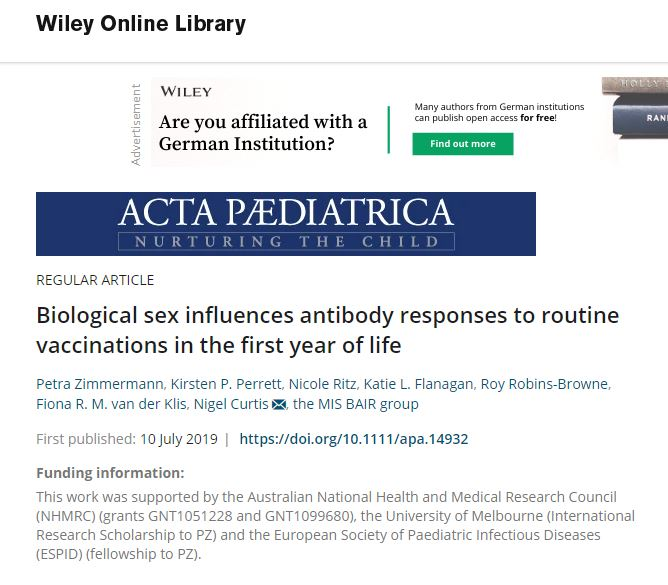Biological sex influences antibody responses to routine vaccinations in the first year of life.
We investigated the effect of early-life factors, namely sex, delivery mode, feeding method and antibiotic exposure, on antibody responses to routine vaccinations administered during the first year of life. One and seven months after the primary course of routine vaccines and 1 month after routine vaccines at 12 months of age, antibodies against 26 vaccine antigens were measured in 398 healthy infants. The geometric mean concentration (GMC) of antibodies (adjusted for effect modifiers with multiple linear regression) and the seroprotection rate for each vaccine were compared for each early-life factor. Sex had an influence on GMCs. Antibody concentrations were significantly lower at 7 months of age in females for tetanus and filamentous haemagglutinin and at 13 months of age for pertactin. In contrast, at 13 months of age, antibody concentrations were significantly higher in females for polio type 3, pneumococcal serotype 6A and measles. Sex did not have an influence on seroprotection rates. Delivery mode, feeding method and antibiotic exposure did not exert a substantial influence on vaccine antibody concentrations. There is a difference between males and females in the humoral response to routine vaccinations in the first year of life.
Authors
Petra Zimmermann; Kirsten P Perrett; Nicole Ritz; Katie L Flanagan; Roy Robins-Browne; Fiona R M van der Klis; Nigel Curtis
External link
Publication Year
Publication Journal
Associeted Project
Microbiology or Immunology
Lista de serviços
-
StructRNAfinder: an automated pipeline and web server for RNA families prediction.StructRNAfinder: an automated pipeline and web server for RNA families prediction.
-
CEMiTool: a Bioconductor package for performing comprehensive modular co-expression analyses.CEMiTool: a Bioconductor package for performing comprehensive modular co-expression analyses.
-
webCEMiTool: Co-expression Modular Analysis Made Easy.webCEMiTool: Co-expression Modular Analysis Made Easy.
-
Assessing the Impact of Sample Heterogeneity on Transcriptome Analysis of Human Diseases Using MDP Webtool.Assessing the Impact of Sample Heterogeneity on Transcriptome Analysis of Human Diseases Using MDP Webtool.
-
Predicting RNA Families in Nucleotide Sequences Using StructRNAfinder.Predicting RNA Families in Nucleotide Sequences Using StructRNAfinder.
-
OUTBREAK: a user-friendly georeferencing online tool for disease surveillance.OUTBREAK: a user-friendly georeferencing online tool for disease surveillance.
-
Noninvasive prenatal paternity determination using microhaplotypes: a pilot study.Noninvasive prenatal paternity determination using microhaplotypes: a pilot study.
-
Editorial: User-Friendly Tools Applied to Genetics or Systems Biology.Editorial: User-Friendly Tools Applied to Genetics or Systems Biology.
-
Automatic detection of the parasite Trypanosoma cruzi in blood smears using a machine learning approach applied to mobile phone imagesAutomatic detection of the parasite Trypanosoma cruzi in blood smears using a machine learning approach applied to mobile phone images
-
Tucuxi-BLAST: Enabling fast and accurate record linkage of large-scale health-related administrative databases through a DNA-encoded approachTucuxi-BLAST: Enabling fast and accurate record linkage of large-scale health-related administrative databases through a DNA-encoded approach
-
Ten quick tips for harnessing the power of ChatGPT in computational biologyTen quick tips for harnessing the power of ChatGPT in computational biology

